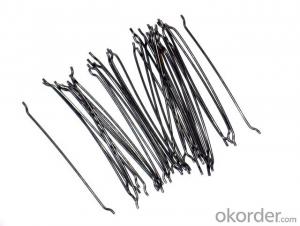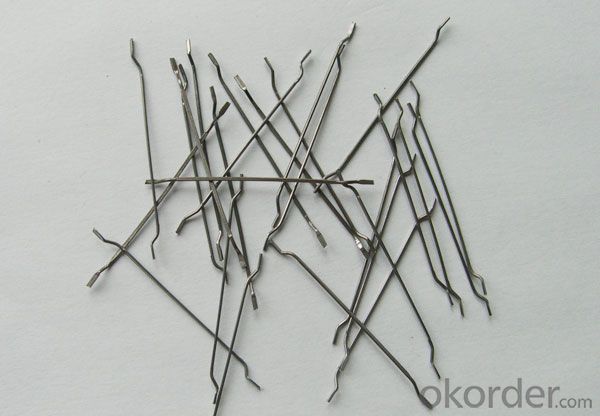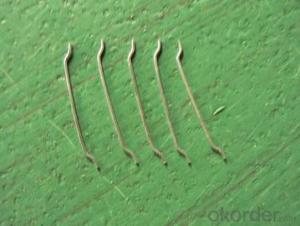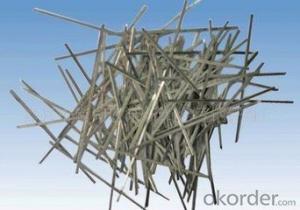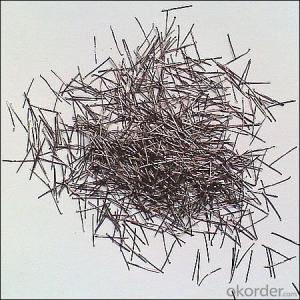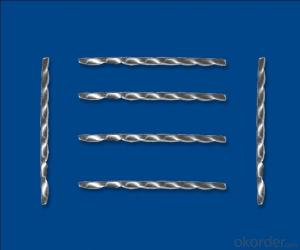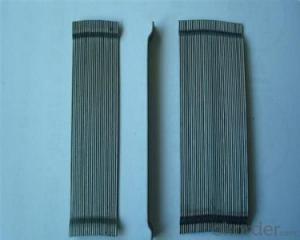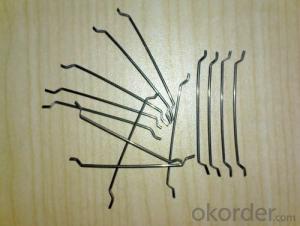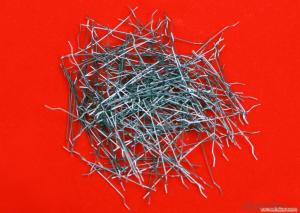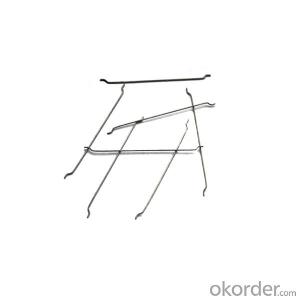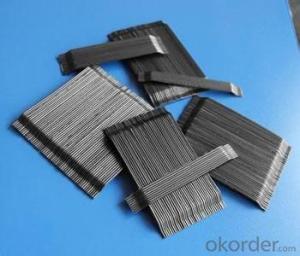Melt Extract Stainless Steel Fiber Loose CNBM International China
- Loading Port:
- Tianjin
- Payment Terms:
- TT OR LC
- Min Order Qty:
- 1000 kg
- Supply Capability:
- 30000 kg/month
OKorder Service Pledge
OKorder Financial Service
You Might Also Like
Quick Details
Place of Origin: Jiangsu, China (Mainland)
Model Number: HT-MC
Material: Color Steel
certificated: ISO 9001
Specifications
The raw material is stainless steel ingots, using electric stoves which melt the stainless steel ingots to become 1500 ~ 1600 ℃ steel liquid, and then with a grooved high speed rotating melt-extracting steel wheel which produces wires that meets are our customers’ specific requirements. When melting down to a wheel steel liquid surface, the liquid steel blow out by slot with centrifugal force at extremely high speed with cooling forming. Melting wheels with water keep the cooling speed. This method is done to produce different material, different sizes of steel fiber.
SIZE | CHEMIC ELEMENT(%) | ||||||
C | P | Mn | Si | Cr | Ni | Al | |
AISI330 | ≤0.40 | ≤0.04 | ≤2.00 | ≤0.75 | 17~20 | 33~37 | |
AISI310 | ≤0.40 | ≤0.04 | ≤2.00 | ≤1.50 | 24~26 | 19~22 | |
AISI316 | ≤0.40 | ≤0.04 | ≤2.00 | ≤1.00 | 16~18 | 10~14 | |
AISI314 | ≤0.40 | ≤0.045 | ≤2.00 | 1.5-3.0 | 23~26 | 19~22 | |
AISI309 | ≤0.40 | ≤0.04 | ≤2.00 | ≤1.00 | 22~24 | 12~15 | |
AISI304 | ≤0.40 | ≤0.04 | ≤2.00 | ≤2.00 | 18~20 | 8~10 | |
AISI301 | ≤0.40 | ≤0.04 | ≤2.00 | ≤2.00 | 16~18 | 6~8 | |
AISI201 | ≤0.40 | ≤0.06 | 5.5~7.5 | ≤1.00 | 16~18 | 3.5~5.5 | |
AISI446 | ≤0.40 | ≤0.04 | ≤1.50 | ≤2.00 | 23~27 | ||
AISI430 | ≤0.40 | ≤0.03 | ≤1.00 | ≤2.00 | 16~18 | ||
NAS430A | ≤0.40 | ≤0.03 | ≤0.50 | ≤0.50 | 16~18 | 2~4 | |
SIZE(mm) | ||||
length | 20 | 25 | 30 | 35 |
width | 0.75~1.5 | 0.75~1.5 | 0.75~1.5 | 0.75~1.5 |
thickness | 0.2~0.75 | 0.2~0.75 | 0.2~0.75 | 0.2~0.75 |
Picture

Steel fiber
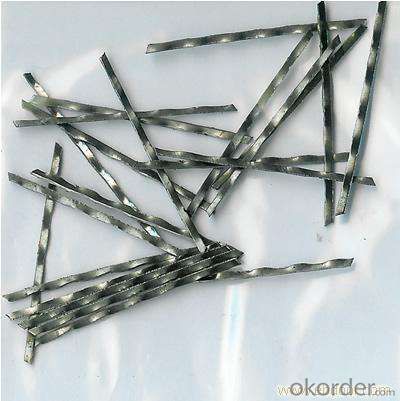

FAQ
1. Metallurgical industry
The refining outside the furnace airbrush, dipping tubes, slag dam, bag lining cover, the triangle electric furnace, furnace cover, the molten iron trench cover, the torpedo cans, coke oven door, the heating furnace of steel rolling door, furnace roof, burn tsui, annular furnace baffle wall, hearth roll, forging steel furnace, steel tanks etc, items can be used for various refractory kiln linings.
2. The construction industry
Steel fiber mixed with mixes clay is rapid development of new composite materials in recent years, especially for the steel fiber concrete fastest development. Steel fiber with excellent tensile, bending, shear and crack resistance, impact resistance, resistance to fatigue, high toughness properties, are all items widely used in construction, road, bridge, tunnel, airport pavement, hydraulic harbor, military engineering, all kinds of buildings and products etc.
3. Kiln
Sintering furnace, reduction furnace, finer, the flue, furnace burning tsui and other heat-resistant linings.
4. Petroleum chemical industry
Especially in the refining the lining of catalytic cracking units.
5. Electric power industry
Thermal power plant boiler heat resistant linings.
6. Environmental protection industry
Incinerator.
- Q: How does melt extract stainless steel fiber contribute to the crack control of concrete?
- The crack control of concrete is greatly enhanced by the incorporation of melt extract stainless steel fiber. These fibers are included in the concrete mix to reinforce and enhance the overall strength and durability of the structure. When concrete experiences shrinkage due to drying or temperature changes, it has a tendency to crack. However, the inclusion of melt extract stainless steel fibers helps to minimize the width and spread of these cracks. The distinctive properties of stainless steel fibers, such as their high tensile strength, corrosion resistance, and excellent bonding with concrete, contribute to crack control. By forming a three-dimensional network within the concrete matrix, these fibers effectively bridge the cracks and restrict their growth. Furthermore, melt extract stainless steel fibers also enhance the ductility and toughness of concrete as a whole. This means that even if cracks do occur, they are less likely to propagate and cause significant damage to the structure. By acting as reinforcement, these fibers enhance the concrete's ability to withstand the forces that cause cracking. In addition to crack control, the inclusion of melt extract stainless steel fibers also improves the overall performance of concrete by providing better resistance against impact, fatigue, and abrasion. This makes them particularly advantageous in high-stress applications such as industrial flooring, tunnel linings, and precast concrete elements. In summary, the addition of melt extract stainless steel fibers to concrete significantly contributes to crack control by reducing crack width, preventing crack propagation, and enhancing the overall strength and durability of the structure.
- Q: Does melt extract stainless steel fiber improve the freeze-thaw resistance of concrete?
- Indeed, the incorporation of melt extract stainless steel fiber undoubtedly enhances the freeze-thaw resistance of concrete. By introducing stainless steel fibers into the concrete mixture, the durability and ability of the material to endure the harsh consequences of freeze-thaw cycles are significantly improved. The distinctive attributes of stainless steel, such as its remarkable tensile strength and resistance to corrosion, effectively strengthen the concrete matrix and prevent any cracks or deterioration caused by freeze-thaw cycles. The fibers function as a reinforcement system within the concrete, providing enhanced resistance against the expansion and contraction that occurs due to freezing and thawing. As a result, this ultimately extends the lifespan of concrete structures and diminishes the necessity for expensive repairs or replacements.
- Q: Are there any specific mixing requirements for concrete with melt extract stainless steel fiber?
- Concrete with melt extract stainless steel fiber has specific mixing requirements. Achieving the desired performance and properties requires ensuring proper dispersion and distribution of the fibers. To incorporate stainless steel fiber into the concrete, it is necessary to add them during the mixing process. Using a high-performance mixer is recommended to ensure even distribution throughout the mixture. Adding the fibers slowly and continuously is important to prevent clumping and ensure thorough integration. The mixing time needs to be extended to ensure proper fiber dispersion. The recommended mixing time depends on the type and length of the stainless steel fiber and the desired concrete properties. Generally, a longer mixing time is necessary compared to conventional concrete mixes for good fiber distribution. It is crucial to avoid excessive mixing as it can cause fiber breakage and reduce effectiveness. Following the manufacturer's guidelines and recommendations regarding specific mixing requirements for the stainless steel fiber is essential. Furthermore, adjusting the concrete mix design may be necessary to accommodate the addition of stainless steel fibers. Modifying the water-cement ratio, aggregate grading, and other mix proportions can achieve the desired workability and performance. In conclusion, proper mixing is vital for concrete with melt extract stainless steel fiber to ensure uniform distribution and maximize the benefits of adding the fibers. These benefits include enhanced tensile strength, crack resistance, and durability. Consulting with the manufacturer or a qualified engineer is recommended to determine the specific mixing requirements for the stainless steel fiber used in your concrete mix.
- Q: Can melt extract stainless steel fiber be used in railway sleepers?
- Certainly, melt extract stainless steel fiber is applicable for utilization in railway sleepers. Known for its exceptional resistance to corrosion and fatigue, stainless steel fiber serves as a robust material. By incorporating it into railway sleepers, the overall strength and longevity of the sleepers are significantly enhanced, rendering them suitable for heavy train loads and extended service life. The melt extract process guarantees the uniform and consistent shape of the stainless steel fibers, thereby further augmenting their performance and dependability. Moreover, the utilization of stainless steel fiber aids in the prevention of crack formation and improves resistance to thermal expansion and contraction, making it an ideal selection for railway sleepers.
- Q: Is melt extract stainless steel fiber suitable for use in marine environments?
- Melt extract stainless steel fiber is indeed suitable for marine environments due to its corrosion resistance properties. This type of stainless steel is well-known for its ability to withstand the harmful effects of saltwater and other corrosive elements commonly found in marine settings. Specifically engineered to possess enhanced strength and durability, melt extract stainless steel fiber is an excellent option for applications that will be subjected to the challenging conditions of the marine environment. Moreover, the fiber's high melting point and capacity to endure extreme temperatures make it highly suitable for marine applications involving exposure to intense heat. In conclusion, melt extract stainless steel fiber is a dependable and efficient choice for marine environments.
- Q: Can melt extract stainless steel fiber be used in self-compacting concrete mixtures?
- Yes, melt extract stainless steel fiber can be used in self-compacting concrete mixtures. The addition of stainless steel fibers enhances the properties of self-compacting concrete, such as improving its durability, crack resistance, and mechanical strength.
- Q: Can melt extract stainless steel fiber replace traditional reinforcement methods in concrete?
- Yes, melt extract stainless steel fiber can be used as a replacement for traditional reinforcement methods in concrete. Stainless steel fiber offers numerous advantages such as enhanced crack resistance, improved flexural strength, and increased durability. It also helps in reducing the formation of shrinkage cracks and enhances the overall performance and lifespan of concrete structures.
- Q: What is the impact of melt extract stainless steel fiber on the drying shrinkage of concrete?
- The impact of melt extract stainless steel fiber on the drying shrinkage of concrete is generally positive. Melt extract stainless steel fiber is a type of reinforcement material that is added to concrete mixes to enhance its properties, including reducing drying shrinkage. Drying shrinkage is the phenomenon where concrete undergoes a reduction in volume as it loses moisture during the curing process. This shrinkage can lead to cracks, which can compromise the durability and aesthetics of the concrete structure. By adding melt extract stainless steel fiber to the concrete mix, the fibers help to mitigate the drying shrinkage. The fibers act as a reinforcement, improving the overall tensile strength of the concrete and reducing the potential for cracking. The melt extract stainless steel fibers are typically distributed evenly throughout the concrete mix, creating a network of reinforcement that helps to restrain the shrinkage. As the concrete dries, the fibers provide resistance to the tensile stresses that occur due to shrinkage, thus minimizing the formation of cracks. Additionally, the stainless steel fibers also enhance the overall mechanical properties of the concrete, including its flexural strength, impact resistance, and resistance to fatigue. This increased strength and durability contribute to a longer service life of the concrete structure. It is important to note that the impact of melt extract stainless steel fiber on drying shrinkage may vary depending on various factors such as the dosage of fibers, the water-cement ratio, the concrete mix design, and the curing conditions. Therefore, it is crucial to carefully consider these factors and conduct appropriate testing and analysis to determine the optimum dosage and performance of melt extract stainless steel fiber for each specific application. In conclusion, the addition of melt extract stainless steel fiber to concrete can effectively reduce drying shrinkage and minimize the formation of cracks. This reinforcement material improves the overall mechanical properties of the concrete, leading to a more durable and long-lasting structure.
- Q: What is the effect of melt extract stainless steel fiber on the early-age cracking of shotcrete?
- The effect of melt extract stainless steel fiber on the early-age cracking of shotcrete is that it helps to reduce and control the occurrence of cracks. The stainless steel fiber enhances the tensile strength and ductility of the shotcrete, minimizing the formation of cracks during the early stages of curing. This reinforcement also improves the overall durability and longevity of the shotcrete, providing a more stable and resilient structure.
- Q: What is the effect of melt extract stainless steel fiber on the bond strength of shotcrete?
- The effect of melt extract stainless steel fiber on the bond strength of shotcrete is generally positive. Shotcrete, also known as sprayed concrete, is a construction material commonly used for its high strength and durability. However, one of the challenges with shotcrete is achieving adequate bond strength between the concrete and the substrate or reinforcement. Melt extract stainless steel fibers, when added to shotcrete mixtures, can significantly improve the bond strength of the sprayed concrete. These fibers are made from stainless steel and are designed to enhance the mechanical properties of concrete. When melt extract stainless steel fibers are incorporated into shotcrete, they create a three-dimensional reinforcement network within the concrete matrix. This network helps to distribute and dissipate the stresses and forces that occur during the curing and drying process. As a result, the bond between the shotcrete and the substrate or reinforcement is strengthened. Furthermore, melt extract stainless steel fibers also enhance the crack resistance of shotcrete. They can effectively bridge small cracks that may occur due to shrinkage or other factors, preventing them from propagating and compromising the bond strength. In addition to improving bond strength, melt extract stainless steel fibers can also enhance the overall toughness and ductility of shotcrete. This is particularly beneficial in applications where the shotcrete is subjected to dynamic loads or severe environmental conditions. It is important to note that the effectiveness of melt extract stainless steel fibers in enhancing bond strength may vary depending on various factors, such as the type and dosage of fibers used, the mix design of the shotcrete, and the application method. Therefore, it is recommended to conduct specific tests and evaluations to determine the optimal fiber dosage and application technique for a particular shotcrete project. Overall, the incorporation of melt extract stainless steel fibers in shotcrete can significantly improve the bond strength between the sprayed concrete and the substrate or reinforcement, ultimately enhancing the performance and durability of the structure.
Send your message to us
Melt Extract Stainless Steel Fiber Loose CNBM International China
- Loading Port:
- Tianjin
- Payment Terms:
- TT OR LC
- Min Order Qty:
- 1000 kg
- Supply Capability:
- 30000 kg/month
OKorder Service Pledge
OKorder Financial Service
Similar products
Hot products
Hot Searches
Related keywords
